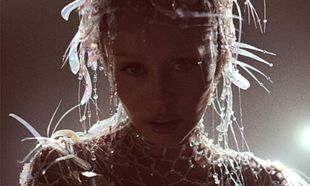A film like Queen of Ireland is unlike any other film in recent Irish history. The effects of the Marriage Referendum on our society haven't yet fully been realised, but it's important that we acknowledge both its importance and its relevance to all corners of Irish life - be it young, old, gay, straight, rich, poor. It was a galvanising experience for us all; it lifted our spirits and made us proud as a nation. So to focus such a momentous event through the prism of a drag artist is no mean feat, but if anyone's able to do, it's Panti.
The story begins as an earnest examination of Rory O'Neill's career and life as the drag act, Panti Bliss, and charts his rural upbringing in Ballinrobe, Co. Mayo through to the early underground scene in Dublin. It's intriguing to note the dichotomy between Rory, the man telling us his story and Panti, the narrator who's driving it all forward with a few caterwaul laughs here and there. As Rory describes his time as a closeted teenager in Mayo, we begin to see the early creation of Panti and how the character is associated with freedom - from social norms and from one's own fears and repressions.Rory's story is a microcosm of Ireland, with him emigrating overseas and finding himself before he eventually returns to Ireland, full of vigour and hope to build upon the opening of Irish society. Through archaic VHS footage, obviously gleaned from his own collection and talking-head interviews, we see a full picture of both the man and the realities of what it was like to be a homosexual in the '80s and early '90s, when the act was still criminalised.
The film changes tone around the halfway point as Rory's comments on The Saturday Night Show and the controversial fallout adds a sense of alacrity to the film and charges it towards the end. We see the momentum, the change in Irish society from benign indifference to the opponents of marriage equality to fully adversarial and, in turn, the film's focus changes to recognise that Ireland hasn't always been a welcoming place for homosexuals. The skill and intelligence comes in the editing; it's made clear that the film was made over an extensive period and the central thesis of it changed during it, but it's not something you'd immediately pick up on.
Horgan's direction and editing is unobtrusive. It's as much Rory confessing his story as it is Panti cackling with glee as she explains one of her stage-show features that includes a bunched-up string of pearls and an Edith Piaf song. The editing is bright and intelligent; never dwelling on one particular shot unless it's necessary and injecting the story with a genuine narrative. The process must have been arduous, going by the sheer amount of footage that was taken during its production. What makes Queen of Ireland so engaging is both its subject matter and the reflective properties of it. We're not seeing just Rory's story, we're seeing Ireland's story told through him. The Queen of Ireland isn't just a film, it's a document that chronicles the changing face of our country in an honest, compelling fashion. The Marriage Referendum gave Ireland a sense of pride and purpose and we have people like Panti Bliss to thank for that.









































































